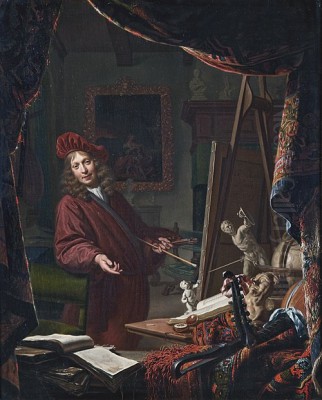
Michiel van Musscher stands as a significant figure in the rich tapestry of Dutch Golden Age painting. Active during the latter half of the 17th century, he carved out a successful career primarily in Amsterdam, becoming renowned for his sophisticated portraits and engaging genre scenes. Born in Rotterdam in 1645 and passing away in Amsterdam in 1705, his life spanned a period of immense artistic and cultural flourishing in the Netherlands. His work provides a valuable window into the society, tastes, and aspirations of the Dutch elite during this prosperous era.
Van Musscher's paintings are characterized by their refined elegance, meticulous attention to detail, and insightful portrayal of his subjects. He possessed a remarkable ability to capture the textures of luxurious fabrics, the intricacies of domestic interiors, and the individual personalities of the people who commissioned his work. Through his art, we gain a sense of the comfortable, cultured, and often opulent lives of the Dutch merchant class and aristocracy.
Early Life and Artistic Formation
Michiel van Musscher's journey into the world of art began in Rotterdam, his birthplace. While details of his earliest years are sparse, it is known that his father was also involved in the arts as a painter and engraver, suggesting an environment where artistic pursuits were likely encouraged. This familial connection may have provided his initial exposure to the techniques and demands of the profession.
Seeking broader opportunities and advanced training, Van Musscher eventually relocated to Amsterdam, the vibrant heart of the Dutch Republic's art market. His artistic education was notably diverse, studying under several masters who specialized in different genres. This broad training would prove foundational to his versatile career. He learned from Martinus Saeghmolen, likely absorbing aspects of history painting or portraiture.
His tutelage continued under Abraham van den Tempel, a respected portrait painter, which undoubtedly honed his skills in capturing likenesses and conveying status, crucial elements for his later success. Further enriching his artistic vocabulary, Van Musscher also spent time learning from Gabriel Metsu, a master known for his refined genre scenes depicting intimate domestic life. This influence is visible in Van Musscher's own genre works.
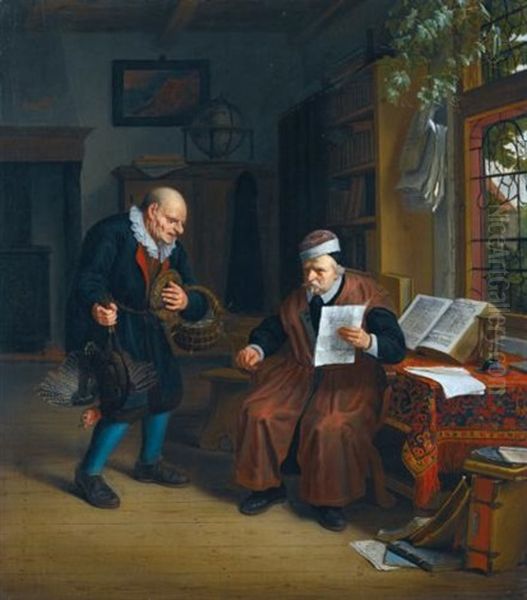
Finally, his education included instruction from Adriaen van Ostade, celebrated for his lively, often rustic, peasant scenes. While Van Musscher's typical subject matter was more elevated than Ostade's, the exposure to Ostade's skillful composition and characterization likely broadened his understanding of narrative and human interaction in painting. This varied apprenticeship equipped Van Musscher with a comprehensive technical foundation and stylistic flexibility.
Establishing a Reputation in Amsterdam
Upon completing his extensive training around the 1660s, Michiel van Musscher established himself as an independent master in Amsterdam. The city, a bustling center of commerce and culture, offered ample patronage for skilled artists, particularly those adept at portraiture. Van Musscher quickly gained recognition for his talent and began attracting a distinguished clientele.
He developed a distinct style that blended the detailed realism characteristic of the Dutch school with an air of sophistication and grace. His ability to render not just a physical likeness but also a sense of the sitter's personality and social standing made him highly sought after. He became known for his elegant compositions and the almost tangible quality he imparted to surfaces, from shimmering silks and velvets to polished wood and reflective metal.
His studio became a destination for Amsterdam's elite – wealthy merchants, influential regents, scholars, and their families sought him out to immortalize their images. His success was built on his technical prowess, his reliability, and his capacity to meet the expectations of a discerning clientele who wished to see themselves presented with dignity and refinement. Van Musscher became one of the leading portrait specialists in the city during the late 17th century.
Artistic Style and Technical Mastery
Michiel van Musscher's art is firmly rooted in the Dutch Golden Age tradition of realism, yet it possesses a distinct elegance that sets it apart. His style is characterized by meticulous detail, smooth brushwork, and a sophisticated understanding of light and shadow to model form and create atmosphere. He excelled in rendering textures, particularly the luxurious fabrics favored by his wealthy patrons – silks, satins, lace, and velvet are depicted with convincing realism.
His compositions are typically well-balanced and thoughtfully arranged, often placing subjects within detailed interior settings that speak to their status and interests. These backgrounds are not mere backdrops but integral parts of the portrait, filled with carefully chosen objects like books, globes, musical instruments, or works of art, adding layers of meaning and context. This attention to the environment reflects the broader Dutch interest in depicting the material world with accuracy and appreciation.
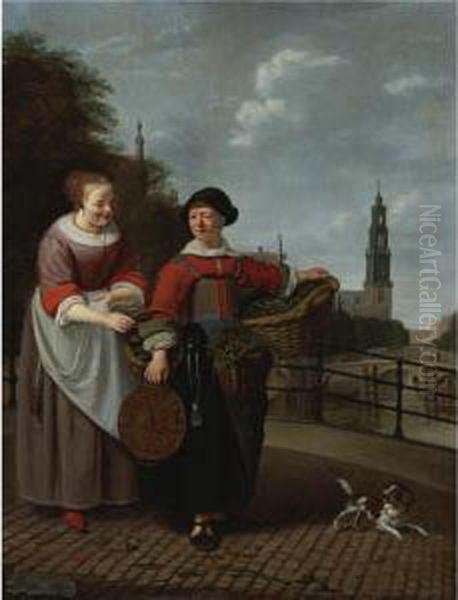
Influences from other masters can be discerned in his work. The elegance and refinement in some of his portraits echo the courtly style popularized by artists like Anthony van Dyck, albeit adapted to a Dutch context. His fine technique and attention to detail, especially in smaller-scale works, show an affinity with the Leiden 'fijnschilders' (fine painters) like Frans van Mieris the Elder, known for their highly polished surfaces and intricate detail. Despite these influences, Van Musscher synthesized them into a personal style that was both accomplished and appealing to his contemporaries.
Genre Paintings and Scenes of Daily Life
While best known for his portraits, Michiel van Musscher also produced a number of genre paintings, depicting scenes of everyday life, albeit often with a refined sensibility. These works showcase his skills in narrative composition and his observation of human interaction. They provide glimpses into the social customs, professions, and domestic environments of the period.
One notable example is A Peasant Offering Poultry To A Lawyer, dated to the 1660s. This work captures a specific social interaction, likely imbued with commentary or gentle humor, typical of Dutch genre painting. It demonstrates his ability, perhaps influenced by his time with Adriaen van Ostade or Gabriel Metsu, to create engaging scenes populated with distinct character types. The setting and details would have been carefully rendered to enhance the narrative.
Another work mentioned is a scene titled Eenhoornsluis (likely depicting the Unicorn Lock bridge in Amsterdam), suggesting an interest in capturing specific locations within the city, blending cityscape elements with genre figures. These works complement his portraiture by offering a broader view of Dutch society, moving beyond the formal presentation of individuals to explore vignettes of daily activity and social dynamics. His skill in rendering interiors and details remained paramount in these compositions.
Esteemed Clientele and Notable Portraits
Van Musscher's success is evident in the high status of his clientele. He painted numerous members of Amsterdam's leading families, including the De Neufvilles and the Rooleeves. His patrons extended beyond the merchant elite to include prominent figures in civic life and even international nobility. He painted a portrait of Johannes Hudde, a mathematician and influential mayor of Amsterdam, signifying his connection to the city's powerful figures.
His reputation reached beyond the borders of the Dutch Republic. Significantly, he received commissions related to the Russian Tsar, Peter the Great, during the Tsar's visit to Holland. Van Musscher painted an Allegorical Portrait of Tsar Peter the Great around 1698, a prestigious commission that underscores his international standing. He also painted representatives associated with the Tsar.
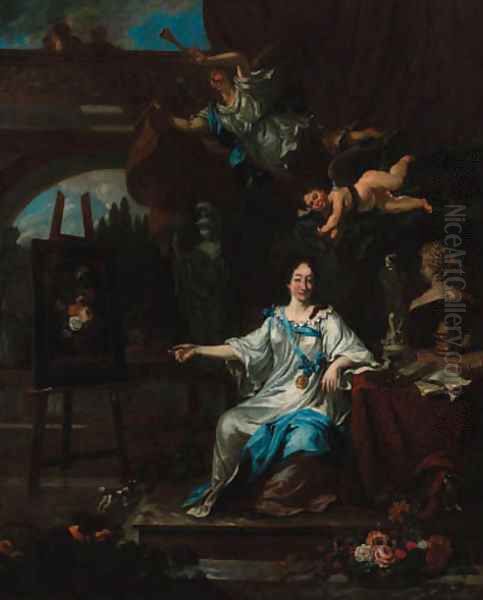
Other important works include the Double Portrait of Isaac Pontanus and Hendrik van Beek (1689), now housed in the Rijksmuseum, showcasing his ability to handle complex multi-figure compositions. His portrait of the writer and diplomat Thomas Hees is another significant example of his work. He also painted fellow artists, most famously captured in his Portrait of Rachel Ruysch, depicting the renowned flower painter in her studio, a work now in the collection of the Metropolitan Museum of Art.
Further examples include the Portrait of the Comans couple, an important early work, and the Portrait of Gerard Pietersz. Hulft, both testifying to his consistent output and appeal among the Dutch elite. The portrait Doctor in His Study (1668) is another fascinating work, depicting a scholar surrounded by the tools of his trade – scientific instruments, books, and natural specimens – offering insight into the intellectual pursuits of the era. He also painted figures like Hendrik Casimir van der Reys (likely Hendrik Casimir II, Prince of Nassau-Dietz) and Maria Neuberg van Schouwenhuysen, wife of Prince Johan Maurits, further cementing his connection to aristocratic circles.
Personal Life, Marriage, and Faith
Michiel van Musscher's personal life saw significant changes that likely influenced his perspective and possibly his art. Born into a Catholic family, he later converted to the Reformed Protestant faith, the dominant religion in the Dutch Republic at the time. This conversion is a noteworthy aspect of his biography, reflecting the complex religious landscape of the 17th century Netherlands.
His family life involved two marriages. His first wife was Eva Visscher, with whom he had two daughters. Following Eva's death, Van Musscher remarried. His second wife was Elsje KlSqlConnection (the surname appears unusual, possibly a transcription variation), a widow who was also a member of the Reformed church. This union brought him a son. These personal milestones – marriage, children, bereavement, and remarriage – unfolded alongside his developing artistic career in Amsterdam.
His father's profession as a painter and engraver provided an artistic lineage, suggesting that Van Musscher was perhaps destined for a creative path. His religious conversion and marriages within the Reformed community would have integrated him more fully into the mainstream Calvinist society of Amsterdam, potentially opening doors to patronage among co-religionists, although he seems to have maintained a broad client base.
Artistic Circles and Contemporaries
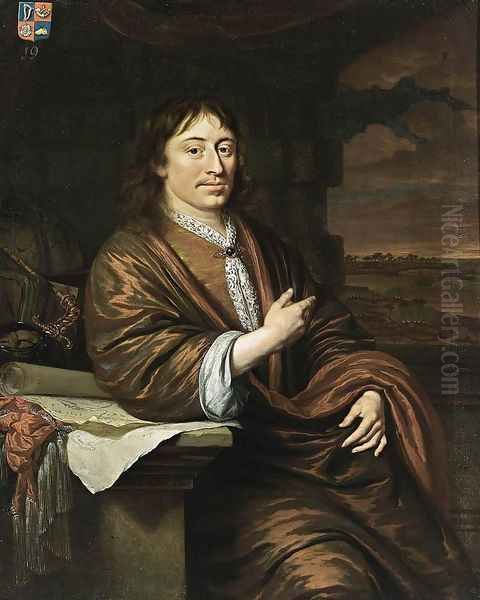
Throughout his career, Michiel van Musscher operated within the vibrant artistic milieu of Amsterdam. His training placed him in direct contact with established masters like Martinus Saeghmolen, Abraham van den Tempel, Gabriel Metsu, and Adriaen van Ostade. These relationships were formative, shaping his technique and stylistic range. His interactions likely extended beyond formal tutelage into the broader community of artists working in the city.
His portrait of the flower painter Rachel Ruysch indicates a direct connection and professional respect between the two artists. Ruysch was one of the most successful female painters of the era, and Van Musscher's depiction of her in her studio is a valuable document of a fellow artist at work. Such interactions, whether collaborations, rivalries, or simple professional acquaintanceship, were common in the close-knit art world of 17th-century Amsterdam.
While direct records of interaction with giants like Rembrandt van Rijn or Johannes Vermeer are lacking, Van Musscher certainly worked in their shadow and was aware of their innovations. Some scholars have noted potential influences or parallels, particularly suggesting that certain compositions by Van Musscher might echo Vermeer's quiet interior scenes, though perhaps without the same profound mastery of light and atmosphere. His style, however, generally aligns more closely with the polished elegance favored in Amsterdam and The Hague, distinct from the bolder styles of Rembrandt or the introspective calm of Vermeer.
The Debate on Originality and Imitation
Despite his success and technical skill, Michiel van Musscher's work has sometimes been subject to critical debate regarding its originality. Some art historians have pointed out instances where his compositions or motifs appear closely derived from the works of other artists, most notably the prominent Amsterdam portraitist Bartholomeus van der Helst. Van der Helst was a leading figure in the generation preceding Van Musscher, known for his large civic guard portraits and elegant individual likenesses.
This perceived reliance on existing models has led to accusations of Van Musscher being a "creative imitator" or even engaging in "theft of honor," suggesting he borrowed too heavily from his contemporaries or predecessors. Such critiques question the degree of innovation in his art, positioning him more as a highly competent synthesizer than a groundbreaking originator.
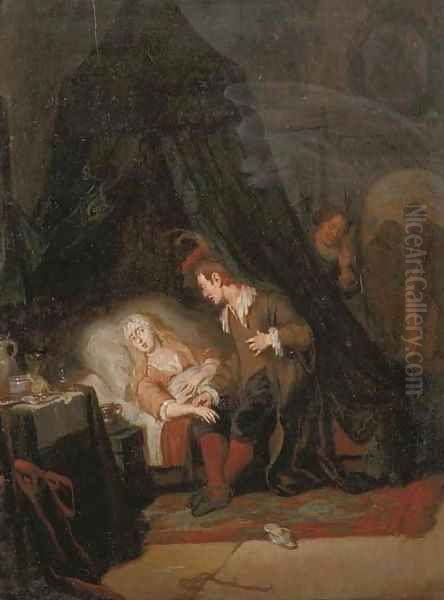
However, other perspectives offer a more nuanced interpretation. The practice of studying and copying the works of established masters was a standard part of artistic training during the Dutch Golden Age. Artists like Peter Paul Rubens and even Rembrandt encouraged their pupils to learn through imitation. From this viewpoint, Van Musscher's adaptation of successful formulas could be seen as part of a legitimate learning process and a savvy response to market demands, rather than a lack of creativity. His ability to absorb various influences and forge a successful career speaks to his skill, regardless of the debate on pure originality.
Legacy and Art Historical Assessment
In the annals of Dutch art history, Michiel van Musscher is recognized as a highly skilled and productive painter, particularly distinguished in the field of portraiture during the late Dutch Golden Age. He is consistently ranked among the most successful portraitists working in Amsterdam in the period after Rembrandt's peak and alongside contemporaries navigating the changing tastes of the late 17th century.
His primary contribution lies in his extensive documentation of the Dutch elite. His portraits offer invaluable insights into the appearance, attire, social status, and cultural values of his sitters. The meticulous rendering of clothing, interiors, and symbolic objects provides rich material for social and cultural historians. His works capture the confidence and prosperity of the Dutch Republic before its gradual decline in the 18th century.
While the debate about his originality persists, his technical proficiency is rarely questioned. His mastery in rendering textures, his delicate brushwork, and his ability to create pleasing and elegant compositions secured his reputation during his lifetime and ensure his continued relevance. His diverse training under masters of history painting, portraiture, and genre scenes resulted in a versatile artist capable of meeting various demands. His depiction of specific social groups, such as Mennonite patrons (as noted by some scholars), further adds to the sociological value of his oeuvre.
Michiel van Musscher remains an important figure for understanding the art market and patronage systems of the Dutch Golden Age. His successful career, bridging connections with local elites and international figures like Peter the Great, exemplifies the possibilities for artists in the thriving Dutch Republic. His paintings continue to be appreciated in museums and collections worldwide for their craftsmanship and historical significance.
Conclusion
Michiel van Musscher navigated the competitive art world of the Dutch Golden Age with considerable success. Emerging from a diverse training background, he established himself as a premier portrait painter in Amsterdam, favored by a wealthy and influential clientele that included local dignitaries and foreign royalty. His style, marked by elegance, meticulous detail, and realistic representation, perfectly captured the aspirations and self-image of the Dutch elite in the late 17th century.
While also contributing to genre painting, his legacy primarily rests on his portraits, which serve as both works of art and historical documents. Though questions about his originality relative to contemporaries like Bartholomeus van der Helst exist, his technical mastery and the sheer quality of his output are undeniable. Studying Van Musscher provides insight not only into an individual artistic career but also into the broader cultural, social, and economic environment of the Dutch Golden Age, solidifying his place as a significant artist of his time.